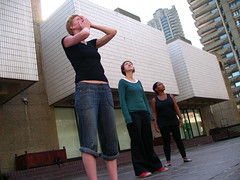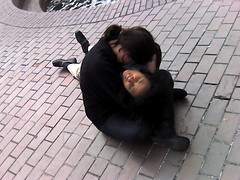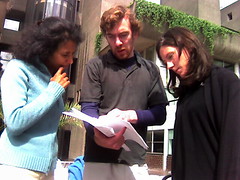After the workshops, in which we played around with ideas and movement, we got down to more frequent sessions on the play itself in July — one evening a week and a few Sundays, building up to every Sunday this month.
 It doesn’t feel quite right to call these “rehearsals” as, so far, most of our time has been spent on creating the play. We had a basic narrative structure and spoken text, from Michael’s original radio script, but it wasn’t clear how this would look as a real play.
It doesn’t feel quite right to call these “rehearsals” as, so far, most of our time has been spent on creating the play. We had a basic narrative structure and spoken text, from Michael’s original radio script, but it wasn’t clear how this would look as a real play.
First we concentrated solely on the movement, blocking things out physically. We’d take one small scene at a time and try things out — how would we represent the actions and emotions? Michael or someone else in the cast might have initial thoughts and we’d try those. We’d experiment with this, tweak it, discuss it, try other things, and, eventually, hopefully, settle on how the scene should work physically. A few weeks ago, having plotted out the basic movements for every scene, we began adding the speech on top of them, working out what fitted where.
Which makes the whole process sound simple.
 This isn’t a “realistic” play — we don’t attempt to recreate particular settings authentically and there are few conversations between characters who are the creation of soul searching Method techniques. My vocabulary for describing theatre isn’t great, but I guess Lilia Litviak is physical and stylised, trying to tell a story and convey the appropriate emotions and tensions without trying to create a reality that could best be done on film.
This isn’t a “realistic” play — we don’t attempt to recreate particular settings authentically and there are few conversations between characters who are the creation of soul searching Method techniques. My vocabulary for describing theatre isn’t great, but I guess Lilia Litviak is physical and stylised, trying to tell a story and convey the appropriate emotions and tensions without trying to create a reality that could best be done on film.
What little knowledge I have of theatre is more focused on “realistic” drama and I’ve had no experience of creating plays from scratch as we’re doing here. Consequently it all feels more scary than it might otherwise and I’ve found it hard to tell whether we’re on track. When working on a conventional scene, with a script, there’s an infinite number of ways the scene can turn out but, I think, you can probably feel when one way of tackling it is working better than another — there’s a more obvious target you’re aiming for: something believable/ recognisable/ real. When the work is more stylised it seems harder to know what the end result should be like — there’s no benchmark of “reality” to mark it against, it’s as if “anything goes”, which is a dangerous amount of freedom.
(I fear these statements are the kinds of things that I’ll look back on and laugh at as being hopelessly wrong but this is how it feels at the moment.)
 With this kind of work it seems harder to be dispassionate about a scene that “feels” right, and to acknowledge that it might not work for an audience. In a “realistic” play you might say “this feels good to me, but I know it looks completely unreal to the audience so we’ll have to come up with something else.” If you’re not trying to recreate realism it seems like there are fewer reasons not to do something.
With this kind of work it seems harder to be dispassionate about a scene that “feels” right, and to acknowledge that it might not work for an audience. In a “realistic” play you might say “this feels good to me, but I know it looks completely unreal to the audience so we’ll have to come up with something else.” If you’re not trying to recreate realism it seems like there are fewer reasons not to do something.
For example, when we were thinking about how to represent flight we tried, as a group, carrying one person around horizontally over our heads. For the person being carried, this feels great — it’s smooth, comfortable, free, and you can imagine yourself flying through blue skies above the crowds. But for the audience it looks like nothing more than a person being carried aloft by other people; the experience of flight is solely within the actor, not shared by the audience, and not much use in the play.
However, when the fliers were gently let down, and their feet reached solid ground, each one had a different reaction to their experience and this seemed interesting and worth keeping. So all our carrying each other round empty rooms has resulted in a single, and hopefully worthwhile, static moment of quiet emotion in the final production.
Now we’ve been through this process for every scene, it’s a matter of putting it all together in time for the production…
(Buy tickets for the show on October 5th or 6th — they won’t be available on the door.)
Commenting is disabled on posts once they’re 30 days old.
